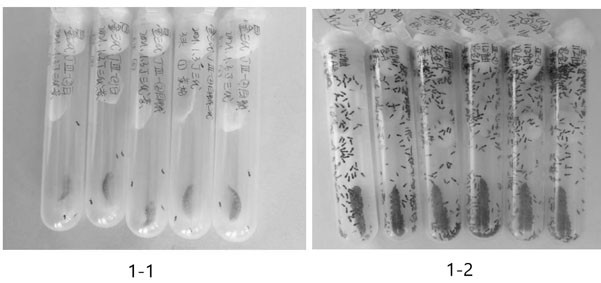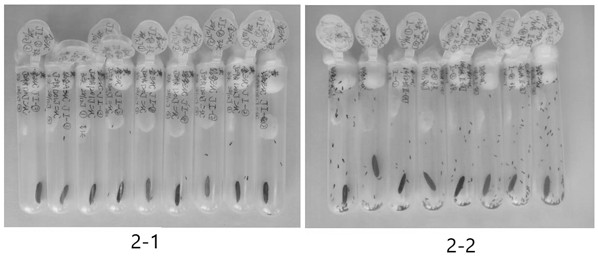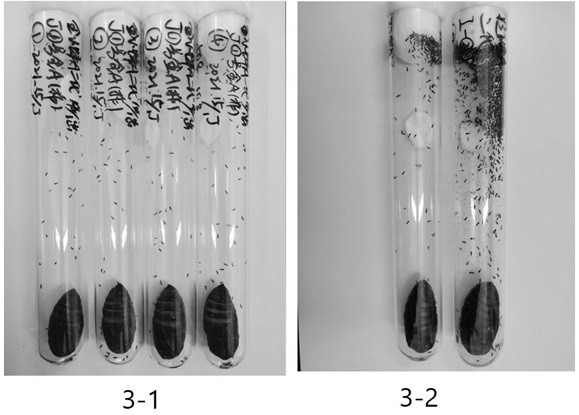Method for preventing and controlling hyphantria cunea by using trichomalopsis genalis
A technology of American white moth and golden bee, which is applied in the monitoring of invasive species, climate sustainability, animal husbandry, etc., can solve the problems of unstable number of breeding bees, low success rate of replacing host bees, etc., to reduce artificial breeding Cost, improvement of labor productivity and equipment efficiency, cost saving effect
- Summary
- Abstract
- Description
- Claims
- Application Information
AI Technical Summary
Problems solved by technology
Method used
Image
Examples
Embodiment 1
[0029] The influence of the breeding method of embodiment 1 different yellow powder beetle pupae on the effect of receiving bees
[0030] Cultivation method of the chrysalis chrysalis Ⅰ: the method of breeding the cotton bollworm golden beetle through gradient cooling of the chrysanthemum chrysalis pupae. It is placed at a temperature of 22-28° C., a relative humidity of 50-70%, and a photoperiod of L:D=16h:8h; it is subcultured in a feeding box with feed such as wheat bran, vegetables and fruits. In the pupation stage, transfer the above-mentioned yellow powdered beetle pupae from 22-28°C into an insect culture box with ventilation holes, and then carry out gradient cooling treatment; the gradient cooling treatment is: placed in a 16°C constant temperature box for 2 hours , and then placed in a 10°C incubator for 2 hours to obtain a pupae with yellow powder for bee inoculation, and place it in a 4°C incubator to protect from light. It can be stored for 1-20 days, so that all ...
Embodiment 2
[0038] Example 2 Comparison of Effects of Different Alternative Hosts for Breeding the Cotton Bollworm Golden Bumblebee
[0039] 1. Host Screening Test
[0040](1) Place the white moth pupae parasitized by the cotton bollworm golden beetle collected in the field at a temperature of 22-28°C, a photoperiod L:D=16h:8h, and a relative humidity of 50-70% for cultivation , the feed is honey water with a concentration of 5%, and the bee is cultivated until the bee emerges;
[0041] (2) Put the chrysalis chrysalis (see the cultivation method Ⅰ of embodiment 1 chrysanthemum chrysalis for the cultivation method) into the bottom of the 10ml centrifuge tube; insert the female wasp of the cotton bollworm into the centrifuge tube, and the female wasp of the cotton bollworm and the alternative host The ratio of the quantity is 3:1, put a piece of absorbent cotton ball soaked with 5% honey water on the inner wall of the upper part of the centrifuge tube, finish picking bees after 48 hours, r...
Embodiment 3
[0047] The influence of embodiment 3 subculture rearing on the cotton bollworm golden bee
[0048] According to Tenebrio molitor pupae through gradient cooling breeding method (treatment 1), the breeding method of contrast 1, contrast 2, contrast 3 respectively continuous breeding 4 generations, the above-mentioned 1st generation, the 3rd generation of this golden hornet The eclosion rate, male to female ratio.
[0049] Table 3 compares the effects of rearing the golden hornet in subculture
[0050]
[0051] The data in Table 3 shows that: after 6 consecutive generations of breeding by the method of breeding Tenebrio molitor pupae through gradient cooling, the emergence rate of bee species of cotton bollworm A. spp. has increased, and the sex ratio has no significant change.
PUM
 Login to View More
Login to View More Abstract
Description
Claims
Application Information
 Login to View More
Login to View More - R&D
- Intellectual Property
- Life Sciences
- Materials
- Tech Scout
- Unparalleled Data Quality
- Higher Quality Content
- 60% Fewer Hallucinations
Browse by: Latest US Patents, China's latest patents, Technical Efficacy Thesaurus, Application Domain, Technology Topic, Popular Technical Reports.
© 2025 PatSnap. All rights reserved.Legal|Privacy policy|Modern Slavery Act Transparency Statement|Sitemap|About US| Contact US: help@patsnap.com



